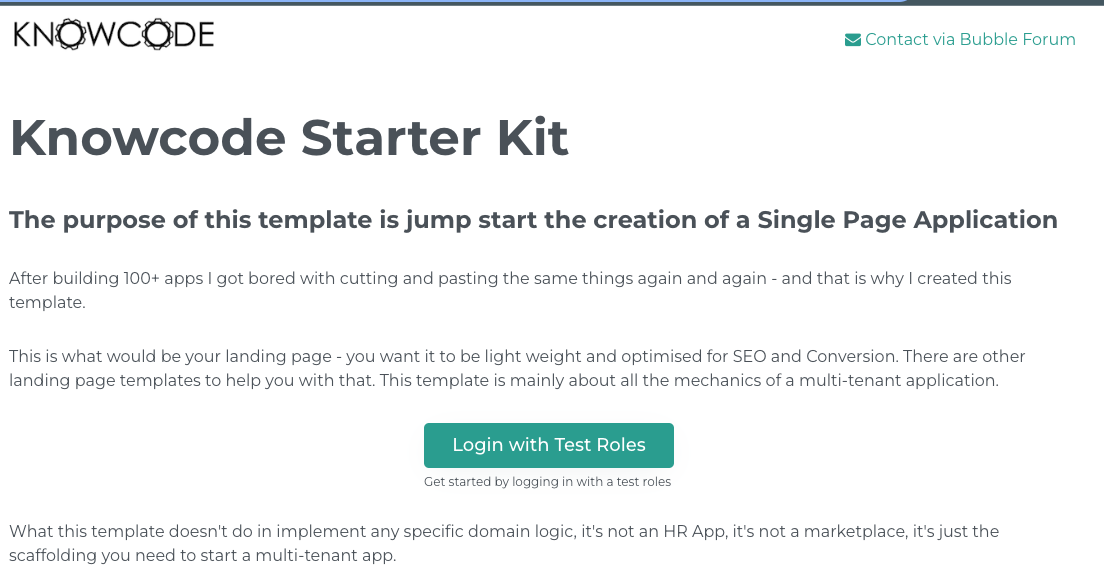Transforming your Bubble.io application into a multi-tenant Software as a Service (SaaS) platform can be a strategic move for scaling your business. However, it comes with its own set of challenges and considerations. In this article, we will explore seven key factors to keep in mind when making this transition.
Fundamentally you will have another level of system admin - the platform administrator that manages the tenants in the application. Then each tenant will have their own Administrator. For every tenant in the Platform, all there own data, config, setup, users, projects, assets etc will be completely isolated to each Tenants visiability.
I've created a template Bubble app that deals with the musch if the generic setup of a Multi-tenant Saa App. https://knowcode-jumpstart-kit.bubbleapps.io/
1. Database Design
The foundation of a multi-tenant system lies in your database design. You must ensure that every piece of data in your database can be attributed to a specific tenant. Achieving this is relatively straightforward; you can add a "tenant" column to every field in the database and associate a "Tenant" attribute with every user in your system. Bubble's feature of privacy rules, lends itself to easy control & access so that each user can only view data related to their respective tenant.
Use Bubble's search to identify where you are creating new Things in your Bubble database. Set the Tenant onto any newly created thing to the Tenant id of the creator.
2. Tenant Table
Create a "Tenant" table in your database to store tenant-specific information such as their name, licensing details, billing information, and unique credentials for third-party services. Make sure to add a "tenant" field to every table in your application and associate it with your users. During migration from a single-tenant setup to a multi-tenant model, remember to update the tenant IDs for all records, starting with your users.
3. Third-Party Services
Consider the third-party services integrated into your application. These services may not inherently support multi-tenancy and could pose challenges. Third-party services often prefer to sell licenses per customer user, which may conflict with your multi-tenant model. Review their terms and conditions to ensure you can use their services in a multi-tenant way. Additionally, assess whether your tenants might want to bring their own third-party services instead of relying on your embedded options.
Examine any call-backs that are updating your Bubble database. Check they correctly update the database by tenant.
4. Credential Storage
In Bubble.io, plugins typically store credentials at the plugin level properties. Ensure you can manage multiple sets of credentials if necessary. Think about how you'll handle different credentials per tenant. Some plugins support multiple credentials per instance, simplifying the process. However, remember that managing credentials can be one of the more complex aspects of multi-tenancy in a Bubble app.
5. Managing Variations Between Tenants
Balancing customization options for tenants can be challenging. Depending on your business model, you may need to offer various levels of customizability, from simple branding changes to full-scale feature requests. Be prepared to manage multiple versions and consider how much customization you can realistically provide without compromising your platform's efficiency.
6. Pricing and Modules
Develop a pricing strategy that caters to different tenant requirements. Some tenants may want additional modules or features. Consider versioning your modules and pricing accordingly. Decide whether access to the platform includes all updates or if certain features should be add-ons. Striking the right balance is crucial for attracting and retaining customers.
7. Instrumentation and Cost Attribution
Tracking the usage and costs associated with each tenant can be challenging. Bubble apps lack built-in mechanisms for assigning costs to tenants directly. You may need to rely on proxy measurements to estimate costs per tenant. Understand that micro-charging for every usage can be complex, so consider whether a flat fee per user or per tenant may be more practical.
Conclusion
Converting your Bubble.io application into a multi-tenant SaaS platform can open up new opportunities for growth and scalability. However, it requires careful planning and consideration of database design, third-party services, credential management, customization options, pricing models, and cost attribution. By addressing these seven key considerations, you can successfully navigate the challenges of multi-tenancy and create a robust, customer-focused SaaS platform.

